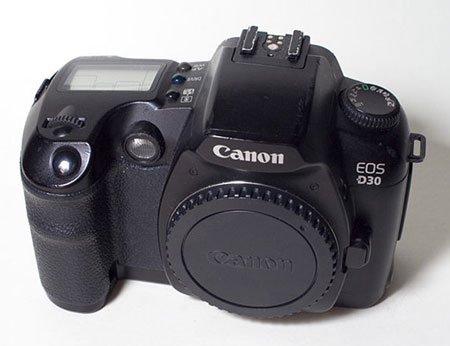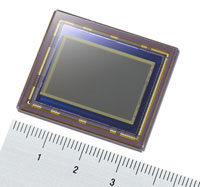The Digital Sensor: A Guide to Understanding Digital Cameras
by Wesley Fink on April 21, 2008 1:00 AM EST- Posted in
- Digital Camera
CCD and CMOS
At the dawn of the digital SLR era, almost every sensor was a CCD (Charge Coupled Device). CCDs were relatively easy to make, but they were and remain basically a single function sensor. CCD sensors create very high image quality and low noise, but they require support circuitry for almost every function provided by the CCD. The CMOS (Complementary Metal Oxide Semiconductor) sensor was always a possible alternative in sensor design, but manufacturing CMOS sensors was very difficult with the technology available at that time. CMOS sensors are inherently lower image quality and higher noise than CCD, which led some experts to predict that a production CMOS sensor for DSLR imaging would never be made.
There are many reasons manufacturers would have preferred the alternative of the CMOS sensor. While difficult to manufacture they are much cheaper to make in volume than CCD sensors. Power consumption for CMOS is inherently lower than the CCD sensor. In addition, the CMOS sensor lends itself to integrating other electronics, such as the analog to digital conversion and noise reduction electronics into the sensor itself - something not really possible with the CCD design.

Those who did not think a commercial CMOS sensor was possible were silenced with the introduction of the $3000 Canon D30 in the fall of 2000. Canon has championed the CMOS sensor, almost exclusively, since that time. However, in the past year other sensor manufacturers have been able to produce their own CMOS sensors. As a result, almost every new sensor introduction in recent months has been CMOS.

In fact, Sony was the first to market with a 12MP+ APS C size CMOS sensor, used in the Nikon D300 and Sony A700. This was followed in about 6 months by the introduction of the Samsung 14.6MP APS-C CMOS sensor in the Pentax K20D. It appears other sensor makers who previously trailed Canon in CMOS development are now the ones pushing the envelope in CMOS sensor development. Sony has also announced a 24.81 effective megapixel CMOS sensor that will be used in a full-frame Sony later this year that will likely be called the A900. The Sony and Samsung thrust into CMOS sensors makes more sense when you realize that Sony and Samsung jointly own several recent patents in CMOS technology. Panasonic is also producing CMOS sensors as seen in their LiveMOS sensors used in the Olympus E-3 and E-501/410/420.

LEFT: Conventional Image CMOS Image Sensor Circuit Structure
RIGHT: Column-Parallel A/D Converter CMOS Image Sensor Circuit Structure
Sony has also taken advantage of another CMOS capability by combining analog to digital conversion and image noise reduction on the CMOS sensor itself in the 12.2MP A700. Some photo review sites had apoplectic fits when they realized Sony was doing noise reduction on the A700 chip, but this is an inevitable development. This move to larger integration of electronics into the CMOS sensor module is just starting, and it could eventually lead to a much larger scale integration of digital image processing functions into the sensor chip - or even a camera on a chip.










72 Comments
View All Comments
gheinonen - Tuesday, October 14, 2008 - link
I am curious why that CMOS sensor in the high end Canon camera body has excellent low black noise compared to the images from a Fuji Pro S3/S5 with its Super CCD? I have used Fuji Pros since 2004 and have discovered that my black details in low light situations include a lot of random color noise which I do not see when reviewing images from the 1DS Mark2 body. What does the Canon body do to eliminate the random color noise in low light black detail? Is it the CMOS Sensor? Is it the body processing?Separately, the white detail on my Fuji Pro S3 has such expanded dynamic range that I can shoot higher exposures and then lower the exposure back to normal in software and it appears to lower or mask the noise floor in the same way that Dolby Noise Reduction works for audio.
bonedaddy - Wednesday, April 30, 2008 - link
I've been a 35 mm fan for years, and have a significant investment including multiple lenses, macro, ring lights etc. For trips etc the smaller cameras seemed fine--always had small 35 mm, for instance. However, re the digital small cameras, the amount of compression is really disappointing.Is my only choice to go back to a body/lens SLR if I want wide angle and telephoto capability AND good resolution?
Midwayman - Thursday, May 1, 2008 - link
No. But if you want wide/tele and really good high iso performance a SLR is where you need to be. PS camera have alway been a compromise. Small 35mm film cameras had focus issues, and lens issues too. Plus most people use iso 200-400 film which has reasonable quality even in a PS digital camera. The biggest difference is now we're blowing up the picture to 1:1 on our monitors and can see the quality defects easily. I bet if you printed your old compact photos at something like 16x20 you'd probably be unhappy with them too. That's the sort of scale we're looking at on our monitors zoomed in.CyniCat - Thursday, April 24, 2008 - link
Good article, but one glaring mistake: you claimed Sony was the first to make a 12+Mpixel CMOS sensor. I think you meant the first AFTER Canon - the 5D, with its 12.8Mpixel sensor, was on the market in 2005, and the 1Ds Mark II, with a 16Mp sensor, was on the market earlier than that.On a different front, I thought the Nikon D3 was using a Sony sensor, not a Nikon?
Wesley Fink - Friday, April 25, 2008 - link
The 5D and 1Ds II and III are full-frame sensors. The Sony was the first consumer (read affordable) APS-C sensor. Canon now has their own 12 megapixel consumer sensor in the XSi, which we are now reviewing.Nikon did their own designs for the D3 sensor, but they do not, to our knowledge, have the capabilities to manufacturer that sensor. Sony has manufactured sensors for them in the past and present with the D300, D60, D80, and others.
Since the new full-frame is CMOS it is likely manufactured by Sony, or possibley Samsung. Sony and Samsung (who make the Pentax 14.6 megapixel sensor) jointly own several patents on CMOS manufcaturing technology.
Wesley Fink - Friday, April 25, 2008 - link
That should read the read "First consumer 12 megapixel APS-C sensor". As mentioned several times in the article Canon pioneered CMOS technology in a consumer DSLR with the Digital Rebel.Midwayman - Wednesday, April 23, 2008 - link
This article complete skips of fuji's fantastic super CCD technology. Its not really a traditional Bayar array, nor a foveon. True they don't produce a interchangeable lens SLR but they do make prosumer SLR's with their sensor. Also the very notable fuji f30 series cameras were made with this sensor. It was a true triumph in PS camera high iso usability.ElFenix - Thursday, April 24, 2008 - link
fuji makes interchangeable lens SLRs with Nikon F mounts.Midwayman - Friday, April 25, 2008 - link
Hell, then there is no excuse for it not to be included in this article. Especially when it quite clearly states there are no other sensor options at one point.Wesley Fink - Friday, April 25, 2008 - link
There will always be fans of one technology or another who feel slighted. I apologize for that, but Fuji is still basically a Bayer sensor with a differnt pixel shape. I have added the following to the Bayer vs. Foveon page to make Fuji fans a bit happier:"FujiFilm produces one current DSLR with a variant of Bayer technology. It is called the Fuji S5 Pro and is basically a Nikon D200 body with a Fuji Super CCD sensor. The Fuji S5 Pro uses the Nikon lens mount. The Super CCD still uses red, blue and geen pixels in the same standard Bayer ratios. However, the shape of the pixel is hexagonal rather than the squate or rectangular pixels in other Bayer arrays. In the latest version Fuji also added smaller photosites between the normal pixels to gather "dynamic range" data.
Fuji has updated the camera body from the S3 to the S5 in the past year, but the sensor has not been updated for more than 3 years. The current Super CCD is still a 6.3 megapixel sensor, but Fuji specifes it as a 12.3 megapixel due to the addition fo the tiny "brightness" pixels. Tests indicate the true resolution is more comparable to an 8 to 10 megapixel sensor from competitors. The Fuji sensor is still basically a Bayer sensor with a different shape for pixels."
We can probably now all argue whether the Fuji Super CCD is really a Bayer variant or not. It certainly appears that way to me, and as a CCD instead of a CMOS sensor it is need of a serious update if it is to continue as a player in the DSLR market.